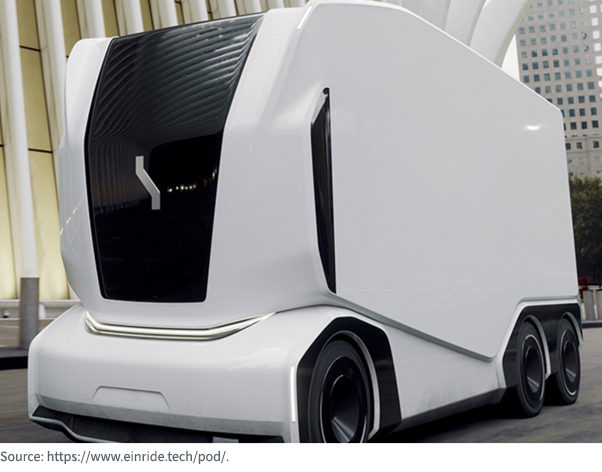Can AI Replace People? The Truck-Driving Case Study


In the present macroeconomic environment, there are many areas of employment where we might wonder whether it could make sense to have humans less involved. Human beings, for instance, might demand higher wages, which could lead to high prices for certain products and services, leading to further inflation and demands for even higher wages. Economists term this the “wage price spiral,” and fighting it is a primary mission of central bankers.
However, if we can take people away from certain tasks, then there would be no more need for wages. As long as the system is maintained and monitored properly, a whole component of cost would melt away.
How close are we to being able to achieve this?
The Case Study of Autonomous Trucks
If we look at the business of trucking across the geographically dispersed U.S., there is already a chronic shortage of drivers. The American Trucking Association notes there is an historic shortage of 80,000 drivers.1 However, it’s important to acknowledge that not all kinds of truck driving are equal. There are2:
- Long-haul truck drivers, who could see their roles at the biggest risk, as they spend the highest proportion of time driving on highways. Repetitive highway driving outside of cities and towns is where artificial intelligence (AI) is most likely to make an impact.
- Delivery drivers, who are at the opposite end of the spectrum as they are frequently navigating small streets and other highly changeable environments, as well as getting in and out of the truck throughout the day.
We have to ensure we frame the topic accurately and recognize that autonomous delivery on small side streets in busy cities is quite a different problem to solve than trucks driving themselves long distances in highway conditions.
In fact, assuming good weather, which is generally the case in the Southwestern U.S., an autonomous truck will see further than a human driver could. The system could also maintain the same level of attentiveness, never growing tired or drowsy. It could also operate 24 hours a day, 7 days per week, with the exception of fueling and maintenance time.
Labor costs typically represent 15% to 20% of the cost of operating a truck. Additionally, the law states that human drivers need to rest, meaning the truck can be used only about 30%–40% of the time.3
If trucks could be run 24 hours per day, 7 days a week, it could increase asset utilization by a factor of two or more.
To put the market in context, the trucking market in the U.S. is around $700 billion in size, while globally it is roughly $4 trillion.4 Even a small gain from autonomous driving in a market this size could equate to very big values.
Global Companies Are Testing on Public Roads in the U.S.
Einride AB is a Swedish firm with a unique looking autonomous truck. It has been typical for autonomous trucks to look at least somewhat like what we are used to, complete with the usual human doors and windows. Einride’s ‘Pods’ are stubby, snub-nosed vehicles, with no driver’s cab.
Figure 1: The Einride Pod

Testing will be done in an operation with GE Appliances on a road between two warehouses in Tennessee.
The Pods have room for about 10 pallets of freight, a capacity of roughly 57,000 pounds. Without onboard drivers, they are managed remotely, and operators can manage more than one vehicle at a time. Einride signed an agreement in 2021 to deliver 300 electric trucks to shipping giant A.P. Moller-Maersk A/S.5
Long-Haul Trucking Can Be the First Step on a Broader Autonomous Journey
Aurora is outlining a market entry sequence for bringing various types of autonomous activity into the market. Trucking is the first segment in the sequence, for the rationale that we mentioned above. For it, Aurora has partnered with PACCAR and Volvo.
The next step in the sequence regards passenger mobility. Aurora indicates that the rollout benefits from the advances that they will make with the truck technologies. They have partnered with Uber and Toyota for this segment.
Finally, the last segment is local goods delivery. It could be that this is the most complex, but it is a large market opportunity valued with a total addressable market opportunity of about $100 billion.6
TuSimple is running a global operation that has made a lot of progress so far7:
- The firm notes more than 500,000 miles of level 4 testing in China
- Its sensors are able to detect out to 1,000 meters
- There are currently around 25 level 4 autonomous trucks in the TuSimple fleet
China’s estimated road freight market value was $750 billion in 2020, and it could grow to $1.3 trillion by 2030.
While the players take different approaches and tend to focus in different markets, it’s clear that significant progress has been made in autonomous trucking.
Conclusion: Still Some Years before Massive Human Job Replacement
Even with the significant progress that we can see, it is not clear exactly when we will see massive amounts of human jobs being replaced with autonomously driven trucks. It is unlikely that in the current cycle of fighting inflation across the supply chain will be materially impacted by developments in this space. Still, the market is so large that we believe investors do have to remain attentive. It’s also clear that autonomous trucking could have the best chance of being utilized at scale.
1Christopher Mims, “Self-Driving Big Rigs Are Coming. Is America Ready?” Wall Street Journal, 6/18/22.
2Steve Viscelli, Driverless? Autonomous Trucks and the Future of the American Trucker, Center for Labor Research and Education, University of California, Berkeley, and Working Partnerships USA. September 2018. http://driverlessreport.org
3Mims, 6/18/22.
4Source: Aurora Investor Presentation, updated as of March 2022.
5Liz Young, “Sweden’s Einride to Test Autonomous Trucks on U.S. Roads,” Wall Street Journal. 6/23/22.
6Source: Aurora Investor Presentation, updated as of March 2022.
7Source: TuSimple 2022 Investor Day Presentation, 5/11/22.
Important Risks Related to this Article
Christopher Gannatti is an employee of WisdomTree UK Limited, a European subsidiary of WisdomTree Asset Management Inc.’s parent company, WisdomTree Investments, Inc.

Christopher Gannatti began at WisdomTree as a Research Analyst in December 2010, working directly with Jeremy Schwartz, CFA®, Director of Research. In January of 2014, he was promoted to Associate Director of Research where he was responsible to lead different groups of analysts and strategists within the broader Research team at WisdomTree. In February of 2018, Christopher was promoted to Head of Research, Europe, where he was based out of WisdomTree’s London office and was responsible for the full WisdomTree research effort within the European market, as well as supporting the UCITs platform globally. In November 2021, Christopher was promoted to Global Head of Research, now responsible for numerous communications on investment strategy globally, particularly in the thematic equity space. Christopher came to WisdomTree from Lord Abbett, where he worked for four and a half years as a Regional Consultant. He received his MBA in Quantitative Finance, Accounting, and Economics from NYU’s Stern School of Business in 2010, and he received his bachelor’s degree from Colgate University in Economics in 2006. Christopher is a holder of the Chartered Financial Analyst Designation.

